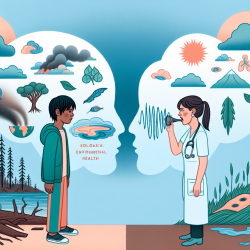Introduction
In the realm of speech-language pathology, practitioners are increasingly called to address not only the linguistic and communicative needs of children but also the broader environmental factors that impact their mental health and well-being. One such emerging concept is solastalgia, which refers to the distress caused by environmental changes that alter one's home environment. This concept is particularly relevant as we consider the implications of climate change and environmental degradation on children's development and mental health.
Key Findings from the Scoping Review
The research article "Mapping the Solastalgia Literature: A Scoping Review Study" provides a comprehensive review of the literature on solastalgia, highlighting its conceptualization, measurement, and implications for practice. The study emphasizes the need for further research using diverse methodologies and greater attention to the practical applications of solastalgia research.
- Conceptualization and Application: Solastalgia is primarily understood as a place-based phenomenon, with a focus on the emotional, mental, and spiritual impacts of environmental change.
- Measurement: The Environmental Distress Scale (EDS) is a key tool used to measure solastalgia, though more quantitative and mixed-method research is needed to validate and expand its application.
- Indigenous Worldviews: The literature calls for greater engagement with Indigenous perspectives and experiences, recognizing the unique relationship between Indigenous communities and their environments.
Implications for Practitioners
For speech-language pathologists working with children, understanding solastalgia can enhance their ability to address the broader environmental and emotional factors affecting their clients. Here are some ways practitioners can integrate these insights into their practice:
- Holistic Assessment: Incorporate questions about environmental changes and their emotional impacts into assessments to better understand the child's context.
- Collaboration with Families: Work with families to identify environmental stressors and develop strategies to mitigate their impact on the child's communication and mental health.
- Advocacy and Education: Educate families and communities about the impacts of environmental change on mental health and advocate for policies that protect children's environments.
Encouraging Further Research
The study highlights the need for additional research, particularly in diverse cultural contexts and with a focus on Indigenous experiences. Practitioners are encouraged to engage in research collaborations that explore the intersections of environmental change, mental health, and communication development in children.
Conclusion
Understanding solastalgia and its implications for child development is crucial for speech-language pathologists committed to fostering positive outcomes for children. By integrating these insights into practice and advocating for further research, practitioners can contribute to a more comprehensive approach to child health and well-being.
To read the original research paper, please follow this link: Mapping the Solastalgia Literature: A Scoping Review Study.










